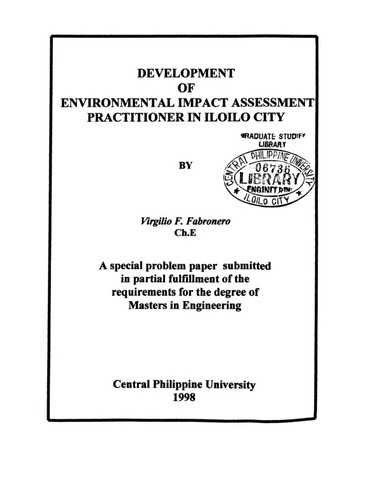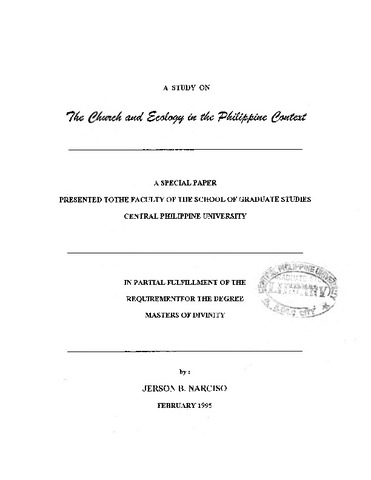Ipakita ang simpleng tala ng item
Development of environmental impact assessment practitioner in Iloilo City
| dc.contributor.adviser | Baldonado, Edith B. | |
| dc.contributor.author | Fabronero, Virgilio F. | |
| dc.coverage.spatial | Iloilo | en_US |
| dc.date.accessioned | 2021-04-08T08:02:04Z | |
| dc.date.available | 2021-04-08T08:02:04Z | |
| dc.date.issued | 1998 | |
| dc.identifier.citation | Fabronero, V. F. (1998). Development of environmental impact assessment practitioner in Iloilo City (Unpublished Master's special paper). Central Philippine University, Jaro, Iloilo City. | en_US |
| dc.identifier.uri | https://hdl.handle.net/20.500.12852/754 | |
| dc.description | Abstract only | en_US |
| dc.description.abstract | In early nineties, the DENR in coordination with the Commission of Higher Education (CHED) conducted a study on the inclusion of subject on environmental science in the school’s curriculum. Results of the study showed that, inclusion and intensification of environmental education were only limited to elementary level while at the college level, it is only limited to engineering course. In Iloilo City, environmental science curriculum was focused on materials and energy conservation, cleanliness and safety that includes pollution. EIA is not included as one of the subjects except at the mastered level at Central Philippine University and University of the Philippines in Visayas. In 1996, DAO 96-37 was promulgated strengthening the implementation of the EIS System. One of its objectives is for the professionalization of the environmental practitioner that has the capability of preparing the EIA study for any proposed development project. It is specifically required that only DENR accredited environmental professional will be allowed to conduct the study and prepares the Environmental Impact Documents. In Region VI, only eight (8) professionals composed of Chemical Engineer, Biologist, Civil Engineer, Mechanical Engineer, and Mining Engineer have been accredited as Level I. Developing EIA practitioners should start at the school as a separate subject or integrated with the subjects on environmental management relation on the tertiary and postgraduate level. It should be institutionalized to develop the expertise not only among the students but the professors as well. Teachers should be trained and allowed to practice to gain more experience to become effective in teaching EIA. School administration should provide teaching materials related to EIA. DENR will continue to provide training’s on EIA and other related policy. | en_US |
| dc.format.extent | iii, 32 leaves | en_US |
| dc.language.iso | en | en_US |
| dc.rights | Attribution-NonCommercial-NoDerivs 3.0 Philippines | * |
| dc.rights.uri | http://creativecommons.org/licenses/by-nc-nd/3.0/ph/ | * |
| dc.subject.ddc | GSL Theses 620.0072 F116 | en_US |
| dc.subject.lcsh | Environmental education | en_US |
| dc.subject.lcsh | Management--Environmental aspect | en_US |
| dc.subject.lcsh | Environmental protection | en_US |
| dc.subject.lcsh | Environmental impact analysis | en_US |
| dc.subject.lcsh | Environmental sciences--Study and teaching | en_US |
| dc.title | Development of environmental impact assessment practitioner in Iloilo City | en_US |
| dc.type | Special paper | en_US |
| dc.description.bibliographicalreferences | Includes bibliographical references | en_US |
| dc.contributor.department | College of Engineering | en_US |
| dc.description.degree | Master of Engineering | en_US |
| local.subject | Environmental impact assessment | en_US |






